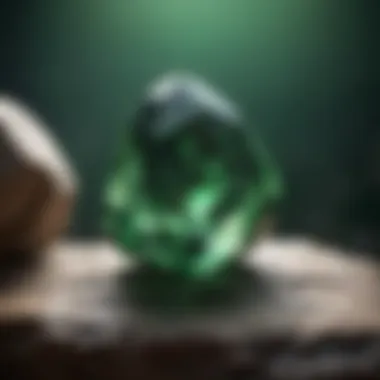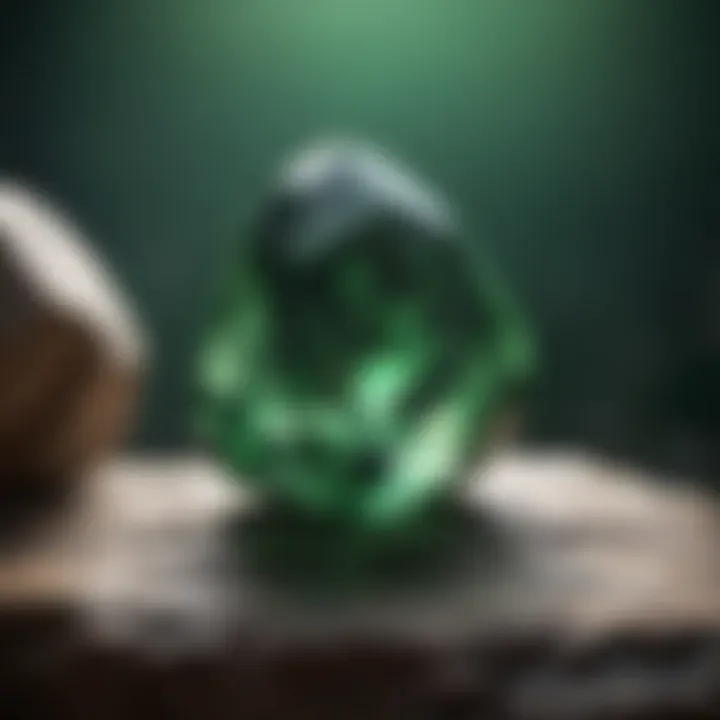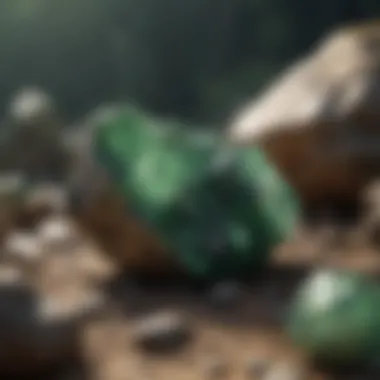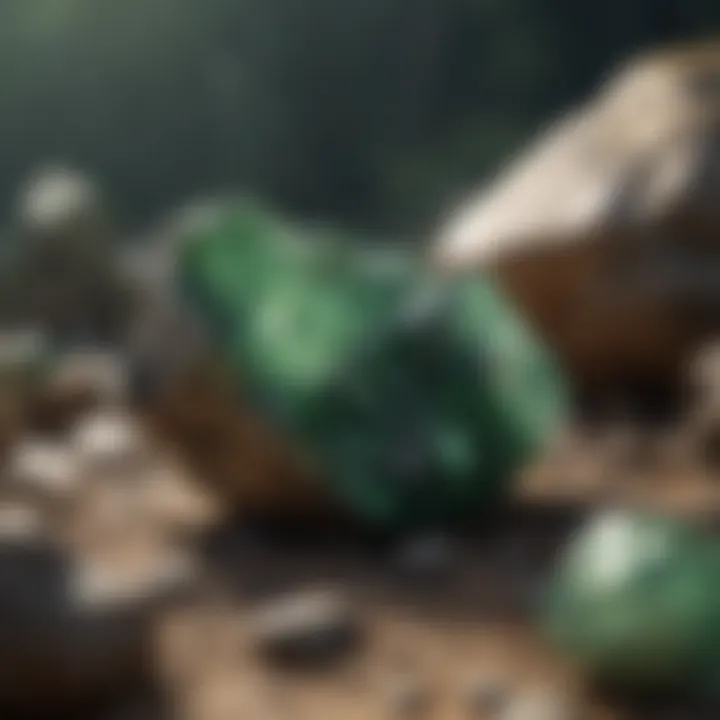Exploring the Fascinating World of Green Rocks


Intro
The study of green rocks opens a window into the intricate story of our planet. These stones, often overlooked, carry with them a wealth of history, formation processes, and a striking variety of appearances. From the edges of emerald hills to the depths of verdant caves, green rocks are not just mere geological phenomena; they weave a narrative that spans millions of years.
The colors seen in these rocks arise from various minerals and elements, with each shade of green hinting at unique properties and origins. When you hold a piece of green rock in your hand, you're not just holding a mineral; you're connecting with the Earth’s geological narrative, a dance of time and processes that shaped its very structure. This Article aims to guide enthusiasts through the captivating world of green rocks, focusing on their history, identification, and practical applications.
History and Origins
Overview of Collectibles, Rocks, and Fossils
Collecting rocks has been a passion for many, from young children with their first rock collections to seasoned geologists seeking rare specimens. Green rocks, in particular, often attract collectors not just for their aesthetic appeal but for the stories they tell. Historically, stones have represented wealth, power, and artistry. Think about jade, which has been cherished in various cultures for its beauty and symbolism.
When you enter a collector's space, you might find stacks of different green stones alongside fossils. These fossils serve as a link to the past, revealing life forms that once roamed the Earth, while the rocks can symbolize the many processes that shaped our planet. Each piece retains a unique history, waiting to be shared.
Historical Significance and Cultural Impact
In many cultures, green rocks hold meanings that transcend their geological attributes. For instance, in ancient times, people in Mesoamerica highly valued jade, believing it to possess spiritual significance, serving as protection or promoting fertility. Likewise, in Asia, jadeite and nephrite have served functions far beyond mere adornments; they were considered auspicious and integral to various rituals.
"Green stones remind us of nature’s palette, presenting not just beauty, but also power and meaning."
Moreover, geology has intertwined with art throughout history. Artists and artisans have crafted sculptures, tools, and ornaments using green stones—each piece not just a representation but a testament to the natural beauty and cultural significance of these materials.
Identification and Classification
Guide to Identifying Rocks and Fossils
Once fascinated by these rocks, one may ask: how do you tell them apart? The identification of green rocks involves observing factors like color, luster, hardness, and texture. For instance, olivine often displays a softer, glassy finish, whereas serpentine appears more waxy.
To identify, you might follow these steps:
- Examine Color: Various shades of green can indicate different minerals.
- Test Hardness: Use the Mohs scale as a guide.
- Look at Luster: Is it glassy, dull, or pearly?
- Feel Texture: Some rocks may have a smoother feel than others.
Once familiar with these attributes, discerning between specimens becomes a gratifying endeavor.
Common Types and Variations
Diving deeper, several notable green rocks capture the attention of collectors:
- Serpentine: Known for its vibrant green hues, often with streaks.
- Jade: Revered for its toughness and historical significance.
- Chrysoprase: A variety of chalcedony, prized for its apple-green color.
- Malachite: Recognized by its banded form and unique patterns.
Each of these carries intrinsic value and commands respect among enthusiasts, making them coveted pieces in collections. Understanding their origins enhances appreciation, as knowing where and how they form adds layers to their story.
As we advance through this exploration of green rocks, the dazzling array of information promises to enlighten rock collectors, hobbyists, and anyone curious about nature’s many wonders.
Prologue to Green Rocks
The exploration of green rocks offers a rich tapestry interwoven with geological wonders and human fascination. These unique specimens are more than just appealing to the eye; they tell a story about our planet's history, composition, and the subtle interplay of natural forces over time. Understanding green rocks is about grasping their geological significance and appreciating their role in various applications, cultural symbolism, and environmental health.
Defining Green Rocks
Green rocks are primarily identified by their distinctive shades of green, which can vary widely. They emerge from a diverse array of geological processes. For example, jade, often regarded as a precious stone, showcases deep greens, while serpentine presents a light, almost vibrant hue. In general terms, green rocks can come from different types of minerals rich in iron, magnesium, or copper, influencing their coloration and properties. These rocks can be igneous, metamorphic, or sedimentary, demonstrating the vastness of their classification.
Classifying these rocks also involves understanding their mineral composition. For instance, malachite is known for its striking banded patterns of green and is categorized under the copper carbonate family. This diversity leads to a plethora of green rocks that cater to various interests from aesthetic beauty to collectible and industrial uses.
The Significance of Color in Geology
In geology, color plays a pivotal role not just in classification but also in comprehending the conditions under which a rock was formed. Green, for example, suggests the presence of specific minerals: olivine, an iron-magnesium silicate found in many basaltic rocks, contributes to a rich green color, indicating high-temperature formation processes.
"Color in geology is not just decoration; it's a window into the rock's history and the conditions it encountered."
Moreover, green hues can signal alterations in environmental conditions, such as the influence of tectonic activity or metamorphism. The vivid greens can often hint at higher metamorphic grades, while darker shades may suggest the presence of copper or other minerals that have been subjected to geological pressure and heat. Understanding these nuances enriches the knowledge of earth's formation processes and opens up new avenues for research and exploration.
In summary, green rocks present a multi-dimensional realm. They entice through their visual appeal, captivate with their geological narratives, and play significant roles in both nature and culture, making them a fascinating subject worthy of study. Their identification and classification serve as a window into understanding the Earth itself.


Geological Formation of Green Rocks
Understanding the geological formation of green rocks is crucial because it provides insights into the processes that shape our planet. Nature doesn’t just throw colors at rocks randomly; the hues and textures are results of intricate interactions between minerals, tectonic movements, and environmental conditions. This section will cover the elemental building blocks, the effects of the shifting earth, and the inevitable impact of erosive forces. Knowing how these rocks come to be isn’t just fascinating—it's essential for anyone keen on serious rock collecting or geologic studies.
Mineral Composition
Silicates
Silicates are among the most common minerals on Earth, and they are perhaps the backbone of many green rocks. They consist mainly of silicon and oxygen, often combined with other elements. A key characteristic of silicates is their tetrahedral structure, where four oxygen atoms link to a silicon atom. This structure allows for a diverse range of compositions and, consequently, a variety of colors—not limited to green, of course.
What makes silicates such a prevalent choice in this context is their stability under varying conditions. Many collectors are drawn to green silicate minerals, such as olivine and diopside, not just for their beauty but also for their durability. Unique features like their hardness and resistance to weathering often make them more appealing for practical use in gemstones or jewel crafting. Yet, it’s essential to note that the very same features can also contribute to challenges when it comes to identification, as some silicates can appear quite similar at first glance.
Oxides
Next up are oxides, which are formed by the combination of oxygen with metals. A significant aspect of oxides is that they can exhibit vibrant colors, including various shades of green, blue, and even red. An example that may catch the eye of rock enthusiasts is chromium oxide, which gives chromite its greenish hue.
Oxides are often simple in composition but complex in appearance. This simplicity can be a boon for identification; however, one downside is that not all oxide minerals are abundant. In essence, while they stand out for their rarer availability, their sheer variety can also make certain types more desirable, particularly for collectors looking to differentiate their collections.
Carbonates
Then, we have carbonates, which include minerals like malachite and azurite. Their formation often involves the interaction of organic processes with weathering. A prominent feature of carbonates is their effervescence in weak acids, making them somewhat easier to identify through a straightforward test.
Another significant point is that carbonates can feature beautiful banding and unique patterns—these characteristics give them a distinct edge among collectors. Yet, despite their aesthetic appeal, they can be softer than silicates or oxides, leading to potential wear and tear over time. When educating rock and fossil collectors, it’s vital to highlight both the allure and the challenges presented by carbonates.
Plate Tectonics and Rock Formation
The dance of tectonic plates is fundamental in shaping all types of rocks, including green varieties. As these plates move, they can create immense pressures and heat, leading to metamorphism. In certain areas, particularly where the plates collide, minerals may be forced together, forming new rocks.
Moreover, plate tectonics not only dictates how green rocks are formed but also where they are found. Regions like the Pacific Ring of Fire are rife with mineral diversity due to volcanic activity and subduction. Each geological formation tells a story, and understanding the tectonic background can provide valuable context for collectors and researchers alike.
Erosion and Weathering Processes
Erosion and weathering work hand-in-hand, shaping not just landscapes but also the rocks themselves. These processes can bring hidden colors to the surface by breaking down more massive formations. With time, water, wind, and ice wear away layers, resulting in the exposure of green minerals, which may have lain hidden for aeons.
Moreover, understanding these processes is incredibly important for collectors who wish to preserve their specimens. Each time a rock is unearthed, it has a story etched into its layers of color and composition, which the elements have helped shape.
In summary, the geological formation of green rocks offers a deeper appreciation of their complexity and beauty. Through the lens of mineral composition and the dynamic forces of nature, one can better understand what makes these green treasures so captivating.
Types of Green Rocks
The discussion of green rocks reveals much about our planet and its processes, making this section a pivotal part of our exploration. By understanding the diverse types of green rocks, readers can appreciate both their natural beauty and geological significance. Each type carries its own unique story, shining a light on the interconnections between geology, culture, and practical applications.
Jade: Valued Gemstone
Cultural Importance
Jade holds a distinguished place in many cultures, especially in East Asia, where it is revered not just for its beauty but also for its perceived spiritual significance. This appreciation goes beyond aesthetics. In China, for instance, jade is often associated with immortality and virtue. It has been said that jade can protect the soul, serving as both a talisman and a symbol of status. This cultural weight makes jade more than just a gemstone; it becomes a means of expressing identity, family heritage, and cultural pride.
The key characteristic of jade that elevates its cultural significance is its durability and luster. When crafted into intricate pieces, jade can last for generations, often becoming heirlooms passed down through families. However, its rarity in some shades, particularly the coveted imperial jade, can lead to soaring prices, adding a layer of exclusivity that attracts collectors and buyers alike.
Varieties of Jade
Jade encompasses two main varieties: jadeite and nephrite. Each variety comes with its own unique properties and aesthetics, contributing richly to the landscape of green rocks. Jadeite, often regarded as the more precious of the two, is characterized by a wide range of colors and translucency. Nephrite, on the other hand, is typically seen as more opaque but still valued for its unique textures and colors.
The array of colors found in jade can greatly influence its market value. From deep emerald greens to subtle shades of light green, the variances affect both desirability and pricing in the world of collectors. However, the overwhelming cultural significance of jade in regions like China typically overshadows its variety, making it a staple not just in jewelry but also in art.
Serpentine: The Stone of Rejuvenation
Serpentine derives its name from its serpent-like appearance, and it provides both aesthetic appeal and metaphysical properties. It is believed to carry rejuvenating qualities, making it a popular choice for individuals seeking emotional balance and healing. Serpentine’s distinct shade of green can vary from soft, muted tones to more vivid, vibrant hues, each having its own charm. As a gemstone, it is often polished and fashioned into various decorative items, enhancing its appeal to collectors.
Green Apatite: Rare and Stunning
Green Apatite is known for its beautiful and vibrant shades of green, often resembling the coveted color of emerald without the hefty price tag. This mineral is relatively rare, adding to its allure and making it a favorite among serious collectors. Alongside its aesthetic qualities, green apatite is also known to promote creativity and expression, making it desirable not just for collectors but also for those who value its metaphysical properties.
Green Fluorite: Collector's Delight


Green Fluorite is prized for its strikingly vivid color and the way it can exhibit a rainbow of greens under different lights. Collectors appreciate its unique octahedral crystal form, which sets it apart from many other minerals. Beyond visual appeal, fluorite has industrial applications in steel production, making it an interesting blend of beauty and utility. Collectors often seek specific specimens that highlight its color and clarity, fueling its desirability in rock and mineral exhibitions.
Malachite: Nature's Artwork
Malachite stands out not just for its rich, vibrant green but also for its fascinating banded patterns. Each piece tells a story, resembling nature’s own artwork crafted over millennia. Its use dates back to ancient civilizations, where it was prized for both its beauty and for purported protective properties. Today, collectors are drawn to malachite for its unique aesthetic qualities, which lend themselves beautifully to jewelry and décor. As a result, it has become a staple in both the gemstone market and artistic circles, showcasing how natural forms can evolve into works of art.
Identification of Green Rocks
When it comes to green rocks, identification is crucial for both collectors and enthusiasts. Knowing how to distinguish various types not only enriches the experience of geology but also aids in assessing the value and applications of these fascinating stones.
The ability to identify different green rocks helps in appreciating their unique qualities. Furthermore, it can protect collectors from potential pitfalls—like misrepresentation or misunderstanding the inherent characteristics of specific stones. This section will guide you through the key characteristics and common testing techniques that can assist in identification.
Key Characteristics
Color Variations
Color variations play a significant role in identifying green rocks. Many people tend to overlook that the shade of green can range from a soft pastel to a vibrant emerald hue. This spectrum might signify different mineral compositions or even the conditions under which they were formed.
- One standout feature of color variation is its link to mineral content, such as the presence of iron, which can deepen or lighten the green tone.
- When viewed under different lights, green rocks can display a significant difference in hue. For example, jade varies from a deep green when viewed in natural light to a lighter shade under fluorescent light.
The exploration of these color variations is a substantial part of understanding how to classify green stones and recognize their value.
Luster and Transparency
Another major factor in the identification of green rocks is their luster and transparency. Luster refers to how light interacts with the surface of the crystal—something that can be quite telling.
- Green rocks can display luster types that range from glassy to dull, making it a popular characteristic for collectors looking to discern quality.
- Transparency varies, too; some stones like jade are often opaque, while others, like fluorite, can be translucent. This unique feature allows collectors to identify stones even from afar.
Thus, understanding luster and transparency provides key insights into the overall quality and type of green rock, aiding collectors and hobbyists alike in their endeavors.
Common Testing Techniques
Hardness Test
The hardness test is a simple yet effective way to identify green rocks. Often done using the Mohs scale, this test allows you to check how well a mineral stands up to scratching and abrasion.
- The key characteristic here is a rock's ability to scratch glass, which indicates a hardness of around 5.5 and above on the Mohs scale. Jade and other green minerals can often be distinguished using this method.
- Knowing what materials scratch against each other is essential for collectors.
However, while straightforward, the hardness test may require a careful approach to avoid damaging the samples.
Acid Test
The acid test is particularly useful for identifying carbonate minerals among green rocks. This test involves applying a small drop of acid to the rock's surface to see if a reaction occurs.
- The notable aspect of the acid test is that carbonate minerals will effervesce, indicating that they contain carbonates and distinguishing them from other green rocks like serpentine, which do not react to acids.
- This method is effective and easy to perform, making it a popular technique for rockhounds.
However, it is prudent to carry out this test with care, as some acids can damage certain minerals.
Understanding the identification techniques outlined above provides valuable tools not just for enthusiasts but also for scholars in geology. Recognizing the key characteristics, along with the right testing methods, paves the way for deeper exploration into the captivating universe of green rocks.
Cultural and Historical Significance
The cultural and historical significance of green rocks extends beyond mere aesthetics; they are intricately woven into the fabric of human history and mythology. From ancient civilizations to modern-day beliefs, these vibrant minerals have captured the imagination of many. Their hues evoke a connection to nature, and this connection has often translated into symbolism, ritual, and artistry.
Green Rocks in Mythology
Throughout the ages, green rocks have held a special place in various mythologies. Take, for instance, the revered jade in Chinese culture. It is more than just a beautiful object; it embodies virtue and morality. Ancient legends depict jade as a material that protects its holder, a belief rooted deeply in the spiritual and physical worlds. Similarly, the ancient Egyptians valued green emblematic stones, associating them with rebirth and fertility. The green of the Nile was mirrored in the stones they chose to honor their gods, symbolizing life and vitality.
Moreover, in Native American lore, particular green stones such as serpentine are thought to represent the earth's energy. Tribes used them in traditional healing practices, believing these stones channel positive energy and ward off negativity. As you can see, the narratives surrounding green rocks help shape cultural identities, linking the past to the present through tales that are often marked by reverence and respect.
"Green stones are not just geological specimens but storytellers of human civilization's trials and triumphs."
Use in Ancient Civilizations
Moving beyond mythology, the practical use of green rocks in ancient civilizations showcases their versatility and significance. In Egypt, artisans crafted malachite into eye makeup, as it was thought to ward off evil spirits and protect the wearer's health. The ancient Egyptians had a saying, ‘Eyes that are clear, lead to clarity of thought,’ emphasizing the importance of both the mineral's physical presence and its metaphorical insight.


In Mesoamerica, the Olmec and later cultures like the Maya and Aztec utilized jade in ceremonial objects, jewelry, and even in their burial rituals. This mineral was regarded as the stone of life, serving both decorative and spiritual purposes. Valuable jade artifacts have been unearthed from ancient tombs, showcasing the belief that these materials connected them to their gods in the afterlife.
Additionally, in other parts of the world, stones like green fluorite found their way into daily life. The Romans, for instance, used this stone for decorative mosaics and glass, valuing its vibrancy and clarity. Its application illustrated not just an aesthetics pursuit, but also a desire to embody the virtues associated with it.
Green rocks continue to resonate through time, not just as geological finds but as symbols and tokens of our humanity. The layers of narrative attached to them reveal an ongoing dialogue between nature and culture that adds depth to their physical beauty.
Practical Applications of Green Rocks
Green rocks serve a variety of roles, both in our everyday lives and in specialized fields. From the elegance of jewelry to the utilitarian aspects of industrial use, these rocks are more than just nature's art. Their unique properties make them invaluable, offering not just aesthetic appeal but also significant practical benefits.
Jewelry and Collectibles
Jewelry crafted from green rocks—like jade, malachite, or green quartz—often captures a discerning collector's eye. The rich hues and varying textures create pieces that are not just stunning but also hold cultural meanings. Jade, for instance, isn’t just durable; it symbolizes purity and moral integrity in various cultures, especially among the Chinese community. Moreover, malachite’s swirling patterns and deep green color make it a favorite for artisans, leading to unique designs that tell a story of the earth's geology.
Collectors treasure green gemstones for their rareness and appeal. These pieces carry a sense of history and uniqueness; it's not uncommon for collectors to form communities around these shared passions, sharing insights and trading valuable pieces. Those who delve into collecting also find joy in learning about the origins and distinctive characteristics of each type, enhancing their appreciation for geology further.
Industrial Uses
Industrial applications of green rocks range widely, emphasizing their versatility. Two notable aspects are mining and extraction, as well as manufacturing applications.
Mining and Extraction
Mining and extraction processes allow us to tap into the earth’s wealth while ensuring that the mineral resources are used efficiently. The green rocks, be it greenstone or specific minerals like serpentine, often have high economic value, especially in areas rich in deposits. Their extraction process can create many jobs and boost local economies.
This method has its challenges, however. The environmental impact cannot be overlooked; mining operations may disrupt local ecosystems and landscapes. The balance rests on managing these effects while still obtaining essential materials.
Manufacturing Applications
Moving on to manufacturing applications, green rocks often find their way into tools, insulation materials, and even construction substances. For instance, serpentine is exploited for its asbestos fibers, which were historically used in fire-resistant products—though this is now controversial due to health risks. On the other hand, other green minerals are utilized in producing ceramics or as decorative stone in architectural designs.
The unique attributes of these materials often provide specific advantages. For example, their durability can enhance the lifespan of products made with them. However, there are drawbacks, such as the potential limitations in sourcing and variations in physical properties that might not suit every application or environment.
The diverse uses of green rocks not only accentuate their beauty but also their functional value, impacting various industries from art to construction.
In summary, the practical applications of green rocks are both varied and essential. They extend beyond mere aesthetics into crucial roles in commerce and industry, making them multi-faceted treasures of the Earth.
Care and Conservation of Green Rocks
Caring for and preserving green rocks is not just a matter of maintaining their aesthetic value; it goes deeper into preserving their geological and cultural significance. For collectors and practitioners, understanding the nuances of care can help in ensuring that these natural wonders continue to be appreciated for generations to come. This section dives into cleaning methods and storage considerations, both of which are crucial in preventing damage, enhancing longevity, and showcasing the beauty of these green gems.
Cleaning Methods
When it comes to cleaning green rocks, the primary goal is to restore their natural luster without causing harm. Each type of rock may require a different approach based on its mineral composition and surface characteristics.
- Gentle Washing: Most green rocks can be cleaned using a soft brush and lukewarm soapy water. Use a mild detergent to avoid any chemical damage. Gently scrub the surface to remove dirt and grime. It's best to rinse well afterward to eliminate any soap residue that can dull the shine.
- Stain Removal: For stubborn stains, a solution of baking soda and water often works wonders. Make a paste, apply it gently, and leave it for a short period before rinsing off. Be careful with sensitive stones like jade, which can react negatively to harsh chemicals.
- Avoid Harsh Substances: Stay clear of acidic or abrasive cleaners. They can easily scratch or etch the surface. If a mineral is particularly delicate, consider consulting with a professional before attempting to clean it.
- Drying: After cleaning, allow the rocks to air dry thoroughly in a soft cloth to avoid moisture retention, which can lead to internal damage over time.
Tip: Handle rocks with care during cleaning. Avoid dropping or bumping them against hard surfaces to prevent chips or cracks.
Storage Considerations
Storing green rocks appropriately plays a pivotal role in maintenance. A good storage strategy helps in preserving the integrity and appearance of these geological gems. Here are some considerations to keep in mind:
- Environment: Store rocks in a cool, dry place away from direct sunlight. UV rays can fade their vibrant colors, and excessive heat may cause expansion that leads to cracks.
- Containment: Use padded boxes or drawers lined with soft fabric such as felt. This protects against scratching and allows for both organization and easy access.
- Separation: Avoid stacking rocks on top of each other. Instead, place them in separate compartments. This minimizes the risk of abrasive contact between different minerals, especially when some may have rough surfaces.
- Humidity Control: Consider using silica gel packets to control moisture levels, especially in humid environments. This can help prevent mineral degradation due to dampness.
- Documentation: Labeling each specimen and maintaining a log about their origins, characteristics, and any prior care taken can enhance both the educational and collector's experience.
Culmination: The Enduring Allure of Green Rocks
The world of green rocks is not just a collection of minerals and pebbles; it symbolizes the very essence of nature's artistry and geological processes. This article has traced the vibrant landscape of green rocks, illuminating their origins, properties, and significance in both the natural world and human history. The allure of green rocks extends far beyond their color; it touches upon cultural beliefs, practical applications, and conservation efforts that span generations.
As the conclusion unfolds, it becomes apparent that green rocks hold a significant position in the study of geology. They serve as indicators of specific environmental conditions and geological epochs. Each type—be it jade with its rich history or malachite with its unique patterns—carries stories waiting to be discovered.
Future Insights in Geology
Looking ahead, the field of geology continues to evolve. The study of green rocks promises to yield further insights into the Earth's history and its dynamic processes. Researchers are increasingly focusing on how these minerals can provide clues about the climate changes of the past. For instance, the presence of specific green minerals in sediment layers can indicate historical volcanic activity or shifts in tectonic plates.
In the realm of technology, there's an emerging interest in using certain green minerals in innovative applications. For example, green apatite and similar minerals may advance phosphorous recycling and environmental sustainability efforts, addressing the ongoing challenge of resource allocation and conservation.
As ongoing research unfolds, enthusiasts and collectors alike must remain engaged with scientific advancements. Keeping in touch with platforms such as Wikipedia, Britannica, and specialized forums on Reddit will enrich their understanding and appreciation of green rocks.
Moreover, as communities grow more environmentally conscious, there could be a resurgence in the demand for sustainable mining practices to preserve these geological wonders. Collectors might find themselves not just curators of beauty, but stewards of responsible practices.
In summary, the enchantment of green rocks lies in their multifaceted nature, their stories, and the future they beckon. As geology progresses, so too does the narrative surrounding these captivating green gems, promising an ongoing journey of discovery and adventure.



